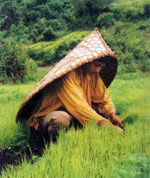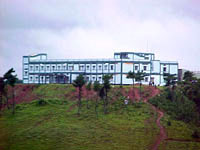Basic facts of Meghalaya
MARKETS
The main markets in the State are the Iewduh, the Iew Sohra, the Iew Musiang, the Iew Langstieh, the Iew Nongstoin in the Khasi and Jaintia Hills, the Tura Market, the Phulbari market, the Garobadha market, the Williamangar market, the Rongjeng market and the Mendipathar market in the Garo Hills.
Iewduh is the biggest market in the State in the heart of Shillong Town. In this market most of the shopkeepers are women. All kinds articles, food items, clothing, hardware, electrical goods, medicines, agriculture implements, handicrafts, audio-visual equipments, etc. are available.
AGRICULTURE
 Meghalaya is basically an Agriculture State with about 81% of its total population depending entirely on Agriculture for their livelihood. The hilly terrain and land conditions of the State do not offer much scope in bringing additional area under wet condition, but the state has a vast potential for developing Horticulture. The agroclimatic variations within the State offers much scope for cultivation of Temperature as well as tropical fruits and vegetables.
Meghalaya is basically an Agriculture State with about 81% of its total population depending entirely on Agriculture for their livelihood. The hilly terrain and land conditions of the State do not offer much scope in bringing additional area under wet condition, but the state has a vast potential for developing Horticulture. The agroclimatic variations within the State offers much scope for cultivation of Temperature as well as tropical fruits and vegetables.
Besides the major food crops of Rice and Maize, the State is also renowned for its Horticulture crops like Orange, Lemon, Pineapple, Guava, litchi, Banana, Jack Fruits and Temperate fruits such as Plum, Pear, Peach etc. Potato, Ginger, Turmeric, Black Pepper, Arecanut, Tezpata, Betelvine, short -staple cotton, Jute, Mesta, Mustard and Rapeseed etc. are some of the important cash crops in the State.
 Apart from the above, the State have achieved signal success in the cultivation of non-traditional crops like Tea, Cashewnut, Oilseeds, Tomato, mushroom, Wheat, etc. are some of the important cash crops in the State.
Apart from the above, the State have achieved signal success in the cultivation of non-traditional crops like Tea, Cashewnut, Oilseeds, Tomato, mushroom, Wheat, etc. are some of the important cash crops in the State.
In order to provide assured irrigation to farmers and thereby ensuring increase food production, a number of Minor irrigation facilities has been envisaged, out of 2.18 lakh hectares estimated irrigation potential both from surface and ground water. Today the State have been able to provide all assured irrigation facilities to an area of 35,500 Hectares.
IMPORTANT FOOD CROPS IN MEGHALAYA
1. Foodgrain 2. Potato. 3. Cotton. 4. Pineapple. 5. Orange and Lemon Livestock and Diary Farming have tremendous potential for generating self employment avenues to the people including educated unemployed youths of the State. The other programme is to assist the people in raising fodder and pasture to graze their cattle and other livestock.
FOREST
The total forest area in the State is 8,510 Sq. Km with only 993 Sq.Kms under the control of the State Government and the rest under the District councils and private managements. The principal timber species are Sal, Teak, Titachap, Gomari, Bol, Pine Birch and Makri-Sal.
The principal forest products include timber, bamboo, reed, broomstick, cane, ipecac, medicinal herbs and plants, cinnamon and thatch grass. Azaleas and rhododendrons grow wild in the forests of Khasi Hills and Jaintia hills and many kinds of beautiful orchids are found in the woods.
Pitcher Plants, the insect -eating plants of botanical wonder is found in plenty in the Jaintia Hills, West Khasi Hills and South Garo Hills District of Meghalaya and it is said that such a plant is found no where else in the world. Many rare and interesting plants are also found endemic to the State like Wild Citrus and Pygmy Lily.
WILDLIFE
Meghalaya is also rich in wildlife. There are elephants, tigers, bears, wild-boars, leopards, golden cats, leopard cats and jungle cats, deer of various kind, binturongs, slow loris monkeys of different types including capped-langurs, golden langurs and hoolock, flying squirrels and giant squirrels. There are also many rare and interesting birds including the hornbills, patridges, pheasants, teals, snipes geese, ducks and quils. All these are protected by law. The State has two National Parks, Viz, Nokrek and Balpakram and two Wildlife Sanctuaries, Viz, Nongkhyllem and Siju.
INDUSTRY
The most important trade in non-agricultural produce is cement from Mawmluh Cherra Cement Company at Sohra. Two mini cement plants have also been set up at Damas in East Garo Hills and at Sutnga in Jaintia hills which have started production, in the private sector, two more mini cement plants are being considered for implementation in East Khasi Hills.
The number of small scale industrial units covering service industry, bakeries, furniture making, iron and steel fabrication, type retreading etc., are increasing and the Government is giving great thrust on entrepreneurship motivation and development.
The Meghalaya Industrial Development Corporation (MIDC) is also assisting private entrepreneurs to set up industries in small and tiny sectors by way of financing and also equity participation.
The Meghalaya Electronics development corporation has set up the Tantalum Capacitor Project At Umiam Khwan. The Unit has since started production. There are about 2000 registered small scale industrial units, with the number gradually rising, providing employment opportunities specially to the educated unemployed youths in the State.
EDUCATION
Although the foundation of modern education in the State was laid by the Christian Missionaries in the 19th century, in accordance with the democratic tradition of the people, the community plays a significant role in setting up and maintenance of schools, This is evident from the fact that, most of Primary, Upper Primary, Secondary Schools and Colleges are under private management, The State Government plays a promotional role in supplementing the efforts of the Community by extending liberal maintenance grant to recognized schools either under deficit or adhoc grant -in- aid system
To keep pace with the national pattern of education, the Government has introduced 10+2+3 pattern in a phased manner.
There are 4099 Primary schools, according to the VI All India Education Survey covering about 88% of the rural population, just within walking distance. Upper Primary education has reached 70% of the rural areas and there are 410 Secondary Schools and 42 Colleges in the State. All the Colleges are affiliated to the central university (North Eastern Hill University).
A State Council for Technical Education have been given special thrust for elimination of illiteracy from the State with the implementation of the total Literacy campaign. The literary rate in the State according to the 2001 census is 63.31 %.
HEALTH
 Like education, the foundation for health care centres was laid by the Christian Missionaries as far back as the 19th century. Yet the health services coverage in the State is much below the national average owing to the hilly terrain with its inadequate road network. To reduce infant and maternal mortality, a number of Family Welfare Programmes have been taken up under Central Government Sponsorship. There are at present 10 Government Hospitals, 12 Community Health Centres, 88 Primary Health Centres and 413 Sub-Centres in the State. The number of beds in the Government Hospitals including Community Health Centres and Primary Centres is 2377.
Like education, the foundation for health care centres was laid by the Christian Missionaries as far back as the 19th century. Yet the health services coverage in the State is much below the national average owing to the hilly terrain with its inadequate road network. To reduce infant and maternal mortality, a number of Family Welfare Programmes have been taken up under Central Government Sponsorship. There are at present 10 Government Hospitals, 12 Community Health Centres, 88 Primary Health Centres and 413 Sub-Centres in the State. The number of beds in the Government Hospitals including Community Health Centres and Primary Centres is 2377.
MINERALS
The State produce Coal, Limestone, Siliminite, Fire-Clay, White Clay, Kaolin, Dolomite, Feldspar, Quartz and Glass sand. The State has deposit of Coal (estimated reserves - 562 million tonnes), Limestone (4500 million tonnes), Fire Clay (million tonnes), which are virtually untapped so far. Seepages of crude oil associated with bubbles of natural gas, have been reported in the southern slopes of Meghalaya and the ONGC is prospecting these areas from time to time.
HYDRO - POWER
Power plays a vital and significant role in growth and development. The State power potentiality for nearly 1200 M.W. It is a power surplus State. About 50 % of electricity generated in the State is supplied to the neighbouring State.
More >>
